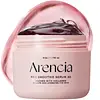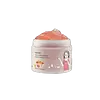What's inside
What's inside
 Key Ingredients
Key Ingredients

 Benefits
Benefits

 Ingredients Side-by-side
Ingredients Side-by-side

Water
Skin ConditioningGlycerin
HumectantNiacinamide
SmoothingArbutin
AntioxidantPropanediol
Solvent1,2-Hexanediol
Skin ConditioningButylene Glycol
HumectantMethylpropanediol
SolventAmmonium Acryloyldimethyltaurate/Vp Copolymer
Acrylates/C10-30 Alkyl Acrylate Crosspolymer
Emulsion StabilisingArginine
MaskingGardenia Florida Fruit Extract
Skin ConditioningEthylhexylglycerin
Skin ConditioningDextrin
AbsorbentAdenosine
Skin ConditioningPolyglyceryl-10 Myristate
Skin ConditioningPolyglyceryl-10 Laurate
Skin ConditioningPanax Ginseng Berry Extract
Skin ConditioningGlyceryl Acrylate/Acrylic Acid Copolymer
HumectantPersea Gratissima Fruit Extract
EmollientRibes Nigrum Fruit Extract
AstringentInonotus Obliquus Extract
Skin ConditioningBrassica Oleracea Acephala Leaf Extract
HumectantPvm/Ma Copolymer
Emulsion StabilisingSaccharomyces/Rice Ferment Filtrate
Skin ConditioningSodium Hyaluronate
HumectantFerulic Acid
AntimicrobialBeta Vulgaris Root Extract
Skin ConditioningVaccinium Vitis-Idaea Fruit Extract
AntioxidantRosa Gallica Flower Extract
AstringentHibiscus Sabdariffa Flower Extract
Skin ConditioningRosa Canina Fruit Extract
AstringentHexapeptide-2
BleachingSoluble Collagen
HumectantHydrolyzed Dna
Skin ConditioningBiotin
Antiseborrhoeic3-O-Ethyl Ascorbic Acid
Skin ConditioningSodium Ascorbyl Phosphate
AntioxidantAscorbic Acid
AntioxidantAscorbyl Glucoside
AntioxidantTocopherol
AntioxidantPanthenol
Skin ConditioningPyridoxine
Skin ConditioningWater, Glycerin, Niacinamide, Arbutin, Propanediol, 1,2-Hexanediol, Butylene Glycol, Methylpropanediol, Ammonium Acryloyldimethyltaurate/Vp Copolymer, Acrylates/C10-30 Alkyl Acrylate Crosspolymer, Arginine, Gardenia Florida Fruit Extract, Ethylhexylglycerin, Dextrin, Adenosine, Polyglyceryl-10 Myristate, Polyglyceryl-10 Laurate, Panax Ginseng Berry Extract, Glyceryl Acrylate/Acrylic Acid Copolymer, Persea Gratissima Fruit Extract, Ribes Nigrum Fruit Extract, Inonotus Obliquus Extract, Brassica Oleracea Acephala Leaf Extract, Pvm/Ma Copolymer, Saccharomyces/Rice Ferment Filtrate, Sodium Hyaluronate, Ferulic Acid, Beta Vulgaris Root Extract, Vaccinium Vitis-Idaea Fruit Extract, Rosa Gallica Flower Extract, Hibiscus Sabdariffa Flower Extract, Rosa Canina Fruit Extract, Hexapeptide-2, Soluble Collagen, Hydrolyzed Dna, Biotin, 3-O-Ethyl Ascorbic Acid, Sodium Ascorbyl Phosphate, Ascorbic Acid, Ascorbyl Glucoside, Tocopherol, Panthenol, Pyridoxine
Punica Granatum Fruit Water
AstringentGlycerin
HumectantButylene Glycol
HumectantSodium Hyaluronate
HumectantPanthenol
Skin ConditioningBetaine
HumectantAllantoin
Skin ConditioningCitrus Tangelo Peel Powder
Gardenia Taitensis Callus Extract
AntioxidantAscorbic Acid
AntioxidantHibiscus Syriacus Flower Extract
AntioxidantFicus Carica Fruit Extract
HumectantCamellia Sinensis Flower Extract
PerfumingRosa Rubiginosa Seed Oil
EmollientMorus Alba Fruit Extract
AntioxidantLycium Barbarum Fruit Extract
AstringentFragaria Ananassa Fruit Extract
Skin ConditioningAquilaria Malaccensis Stem Extract
AntioxidantHydroxyethyl Acrylate/Sodium Acryloyldimethyl Taurate Copolymer
Emulsion StabilisingCarbomer
Emulsion StabilisingPolyglyceryl-10 Laurate
Skin ConditioningPolyglyceryl-10 Myristate
Skin ConditioningOrange Roughy Oil
Skin ConditioningLitsea Cubeba Fruit Oil
MaskingTromethamine
BufferingEthylhexylglycerin
Skin ConditioningCaprylyl Glycol
Emollient1,2-Hexanediol
Skin ConditioningPunica Granatum Fruit Water, Glycerin, Butylene Glycol, Sodium Hyaluronate, Panthenol, Betaine, Allantoin, Citrus Tangelo Peel Powder, Gardenia Taitensis Callus Extract, Ascorbic Acid, Hibiscus Syriacus Flower Extract, Ficus Carica Fruit Extract, Camellia Sinensis Flower Extract, Rosa Rubiginosa Seed Oil, Morus Alba Fruit Extract, Lycium Barbarum Fruit Extract, Fragaria Ananassa Fruit Extract, Aquilaria Malaccensis Stem Extract, Hydroxyethyl Acrylate/Sodium Acryloyldimethyl Taurate Copolymer, Carbomer, Polyglyceryl-10 Laurate, Polyglyceryl-10 Myristate, Orange Roughy Oil, Litsea Cubeba Fruit Oil, Tromethamine, Ethylhexylglycerin, Caprylyl Glycol, 1,2-Hexanediol
Ingredients Explained
These ingredients are found in both products.
Ingredients higher up in an ingredient list are typically present in a larger amount.
1,2-Hexanediol is a synthetic liquid and another multi-functional powerhouse.
It is a:
- Humectant, drawing moisture into the skin
- Emollient, helping to soften skin
- Solvent, dispersing and stabilizing formulas
- Preservative booster, enhancing the antimicrobial activity of other preservatives
Ascorbic Acid is is pure Vitamin C. This form makes up the largest amount of vitamin C found naturally in our skin.
Not only is vitamin C great for your overall health and immune system, it also has plenty of benefits on your skin.
Vitamin C is best used for brightening skin. It improves dark spots, acne scars, and hyperpigmentation. This is because it blocks the process of skin darkening when exposed to UV.
Remember: Vitamin C should not replace sunscreen!
Your skin uses vitamin C to build collagen. Collagen is one key component in having a strong skin barrier and plump skin. Vitamin C also plays a role in regulating collagen, thus making it effective in improving wrinkles and fine lines.
Ascorbic acid shows potent antioxidant activity. As an antioxidant, it helps fight free-radicals. Free-radicals are molecules that may damage your skin cells. These antioxidants also protect skin against UV damage.
The best formulations include Vitamin E and/or ferulic acid. These two ingredients help stabilize and provide a boost in the benefits of ascorbic acid. This is because ascorbic acid becomes unstable when exposed to UV and air. In fact, you can tell your ascorbic acid has oxidized when it turns an orange-yellow color.
Ascorbic acid is generally compatible with other ingredients. However, using ascorbic acid with other active ingredients might cause irritation. Two ingredients: copper ions and benzoyl peroxide, will inactivate ascorbic acid completely.
Read more about other types of Vitamin C:
Foods rich with vitamin C include oranges, strawberries, broccoli, bell peppers, and more. When consuming Vitamin C, your skin receives a portion of the nutrients.
Learn more about Ascorbic AcidButylene Glycol (or BG) is used within cosmetic products for a few different reasons:
Overall, Butylene Glycol is a safe and well-rounded ingredient that works well with other ingredients.
Though this ingredient works well with most skin types, some people with sensitive skin may experience a reaction such as allergic rashes, closed comedones, or itchiness.
Learn more about Butylene GlycolEthylhexylglycerin (we can't pronounce this either) is commonly used as a preservative and skin softener. It is derived from glyceryl.
You might see Ethylhexylglycerin often paired with other preservatives such as phenoxyethanol. Ethylhexylglycerin has been found to increase the effectiveness of these other preservatives.
Glycerin is already naturally found in your skin. It helps moisturize and protect your skin.
A study from 2016 found glycerin to be more effective as a humectant than AHAs and hyaluronic acid.
As a humectant, it helps the skin stay hydrated by pulling moisture to your skin. The low molecular weight of glycerin allows it to pull moisture into the deeper layers of your skin.
Hydrated skin improves your skin barrier; Your skin barrier helps protect against irritants and bacteria.
Glycerin has also been found to have antimicrobial and antiviral properties. Due to these properties, glycerin is often used in wound and burn treatments.
In cosmetics, glycerin is usually derived from plants such as soybean or palm. However, it can also be sourced from animals, such as tallow or animal fat.
This ingredient is organic, colorless, odorless, and non-toxic.
Glycerin is the name for this ingredient in American English. British English uses Glycerol/Glycerine.
Learn more about GlycerinPanthenol is a common ingredient that helps hydrate and soothe the skin. It is found naturally in our skin and hair.
There are two forms of panthenol: D and L.
D-panthenol is also known as dexpanthenol. Most cosmetics use dexpanthenol or a mixture of D and L-panthenol.
Panthenol is famous due to its ability to go deeper into the skin's layers. Using this ingredient has numerous pros (and no cons):
Like hyaluronic acid, panthenol is a humectant. Humectants are able to bind and hold large amounts of water to keep skin hydrated.
This ingredient works well for wound healing. It works by increasing tissue in the wound and helps close open wounds.
Once oxidized, panthenol converts to pantothenic acid. Panthothenic acid is found in all living cells.
This ingredient is also referred to as pro-vitamin B5.
Learn more about PanthenolPolyglyceryl-10 Laurate is an ester of lauric acid and Polyglycerin-10.
Polyglyceryl-10 Laurate is a cleansing agent and emulsifier. It helps gather dirt, oil, and other pollutants to be rinsed away. As an emulsifier, it helps prevent ingredients from separating, such as oil and water.
Polyglyceryl-10 Laurate may not be fungal acne safe.
Learn more about Polyglyceryl-10 LauratePolyglyceryl-10 Myristate isn't fungal acne safe.
Sodium Hyaluronate is hyaluronic acid's salt form. It is commonly derived from the sodium salt of hyaluronic acid.
Like hyaluronic acid, it is great at holding water and acts as a humectant. This makes it a great skin hydrating ingredient.
Sodium Hyaluronate is naturally occurring in our bodies and is mostly found in eye fluid and joints.
These are some other common types of Hyaluronic Acid:
Learn more about Sodium Hyaluronate